7 Steps to Conquer EOFY (Financials and Assets)
July 1, 2020 8:44 am | by John Adams
If your financial year ends on 30 June, the sticky notes on your desk are by now likely taking over any leftover free space that you were hoping to preserve this time around. EOFY season is traditionally stressful and the additional challenges brought upon businesses by COVID-19 are considerable. But fear not, we are here to help you. This blog is intended to give you a concise to-do list for running Financial and Assets Year End in SapphireOne.
Please note that processing Payroll Year End is a little different than the procedures needed for Financials and Assets. In our previous blog, we provided a step-by-step guide for a smooth roll over of your Payroll into the next tax year.
You do not need to close your financial year at a specific date and financial Year End can be processed well into the next year. However, you may be legally required to perform an annual stocktake for tax purposes by 30 June. Therefore, many companies choose to run Year End for Assets and Financials separately. If you perform the rollover procedures at different times, you will have to re-run some of the steps.
1. Run Month End
- Send Statements
- Review Budgets
- Record Asset Depreciation
- Lodge BAS/IAS Submission
- Review all essential Reports
- Reconcile any other information with source documents available to you
2. Perform Stocktake
3. Backup of Data File
4. Conduct Data Maintenance
5. Unlock all Periods
6. Process Year End
- a. Assets
- Producing all Reports
- Checking all Depreciation is up to date
- Enter the last period for the year (e.g. “12” if you run a 12-period-year)
- Tick all completed checkboxes and click “continue”
- b. Financials
- Post all Transactions
- Reconcile and Print –
- Trial Balance
- Standard Balance
- Income Statement
- Balance Sheet
- Aged Clients and Aged Vendor Balances
- Reconcile Bank Accounts with Bank Statements
- Run GL Audit Report
- Finalise Statements
- Verify and Complete all Client and Vendor Allocations
- Enter the last period for the year (e.g. “12” if you run a 12-period-year)
- Tick all completed checkboxes and click “continue”
7. Check Periods
- “Assets” once you have run Assets Year End
- “Clients, Vendors, Time Sheets, Sales Analysis, General Ledger and Projects” once you have run Financial Year End
- Cash or money – This is the one of the main assets in business.
- Supplies – Supplies are those types of things that you use or consume in business. Before businesses start using them, they are called supplies.
- Prepaid – Prepaid usually are paid in advance before one can use it, for example pre-paid insurance.
- Inventory – Inventory is when business buy stuff, put price tags on it and invite customer to buy it. Inventory is like store where customers are invited to buy items. Supplies are used inside the business for internal use only and inventory has fresh tag on it and the customers by the inventory.
- Accounts receivable – It is when other people owe you money.
- Land, building, Autos, Equipment – These are long-lived assets but these are still assets as they have future potential value.
- Intangibles – Trademarks are intangibles assets; we can’t touch it but it has probable future economical benefits.
Make sure that all month end tasks have been completed for Financials and Assets. These include:
In most Instances at the end of a financial year you will have run Payroll Month End and then Payroll Year End earlier than you would need to Financials and Assets, as you cannot process any new Payruns for the new financial year until this has been completed (Payroll Year End Blog). Therefore we recommend running “Period End Financials “ and “Period End Assets” separately if this is the case. Alternatively if you are ready to process Month End for your Financials and Assets before you process a new Payrun in the new Financial Year then you can run Month End All, followed by End of Year Payroll and then it is possible to process End of Year Financials and Assets when you are ready.
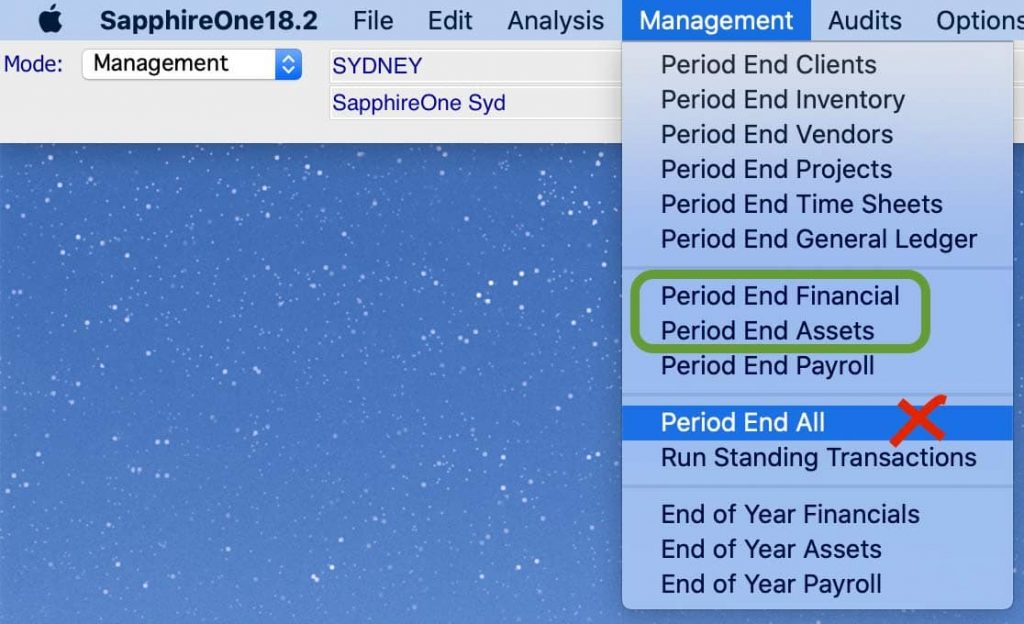
Australian tax law requires you to record the value of all your trading stock on hand as at the end of your income year (30 June). For this purpose, you need to keep records of all transactions related to buying, maintaining, repairing and selling business assets or stock in order to be able to substantiate any amounts and values stated in your tax return.
A Stocktake is performed once all transactions affecting inventory quantities and values for the financial year have been entered and posted so before you commence stocktaking, make sure you have finalised all transactions.
Once you are prepared to undertake financial Year End, it is mandatory to create a master backup of your data file. Also verify that the backup can be read and store it in a safe location before rolling.
Minimise the chance of any errors occurring by running the Re-Index on your SapphireOne server and ensure a Data Compact has been done.
For extra precaution, you can run the Year End procedure on the Single User application with a copy of your data file beforehand to familiarise yourself with the process and to avoid any adverse results when running it on your live data file.
For processing Year End all periods need to be unlocked. Note that you need to do this for all seven functionalities in the dropdown (but not for Payroll).
Go to: Utilities > Controls > Company > Page: Periods and Taxes > Select Unlock All
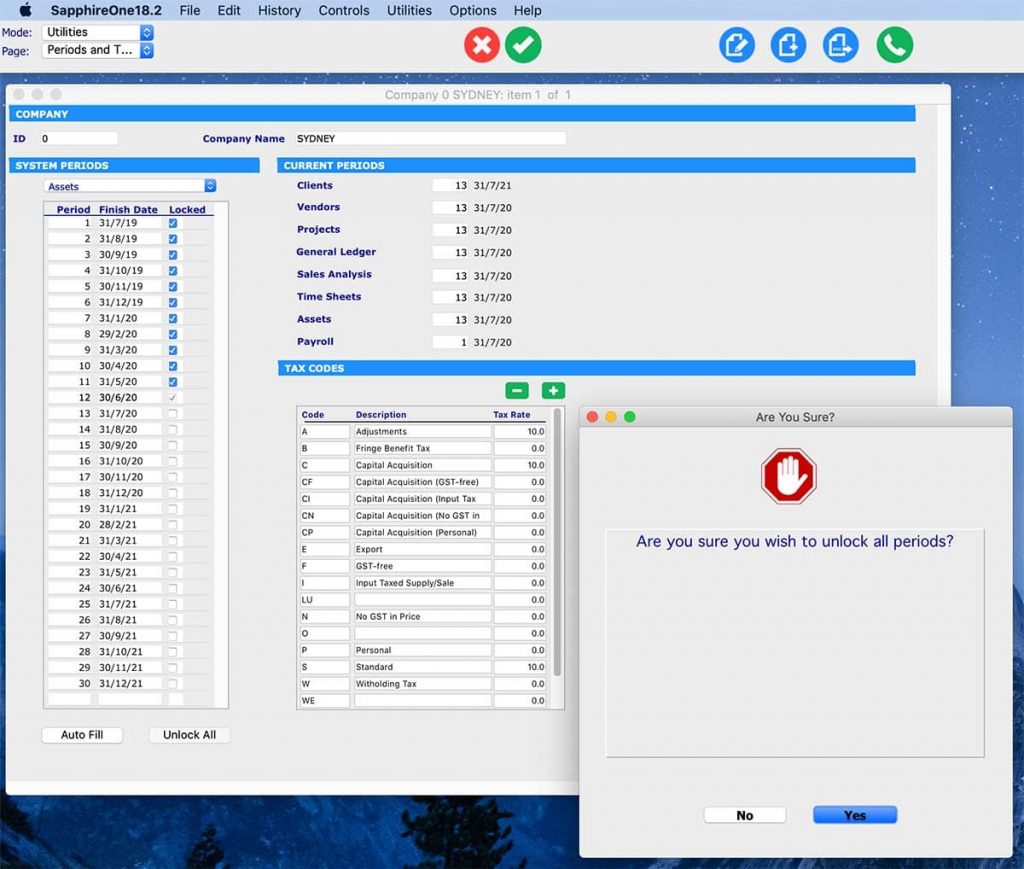
You have the option to run Year End Financials and Assets simultaneously if you have finalised all required steps for both modules at the same time. All you have to do for this is tick “Include Asset” when opting for Year End Financials.
However, it is very important to remember not to tick “Include Payroll” as you will have most likely already run Payroll Year End previously.
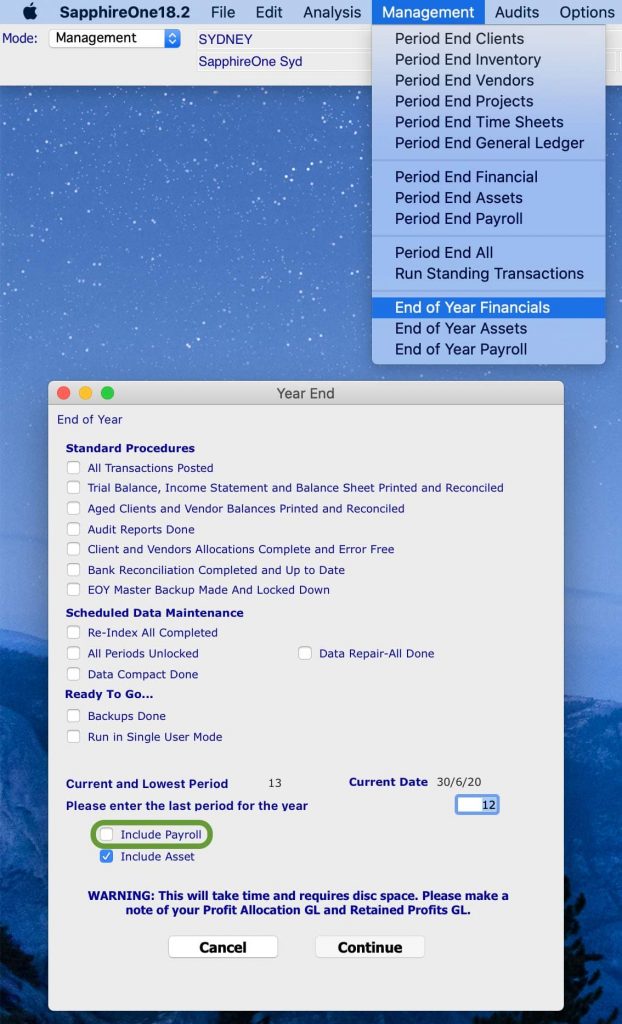
Commence your EOFY processing for Assets by:
Then go to: Management > Management > End of Year Assets
Note that you cannot post your depreciation for the first month of the new financial year until you have rolled over.
Perform the EOFY Rollover Procedures for Financials by:
Then go to: Management > Management > End of Year Financials
Once you have successfully run your End of Year for Financials and Assets, you need to check the periods.
Go to: Utilities > Controls > Select the Company > Page: Periods and Taxes
There is a total of seven functionalities in the dropdown that you need to check the periods for:
Make sure that period 1 is the correct finish date according to your data file. In the example below, period 1 ranges from 30 June 2020 to 31 July 2020.
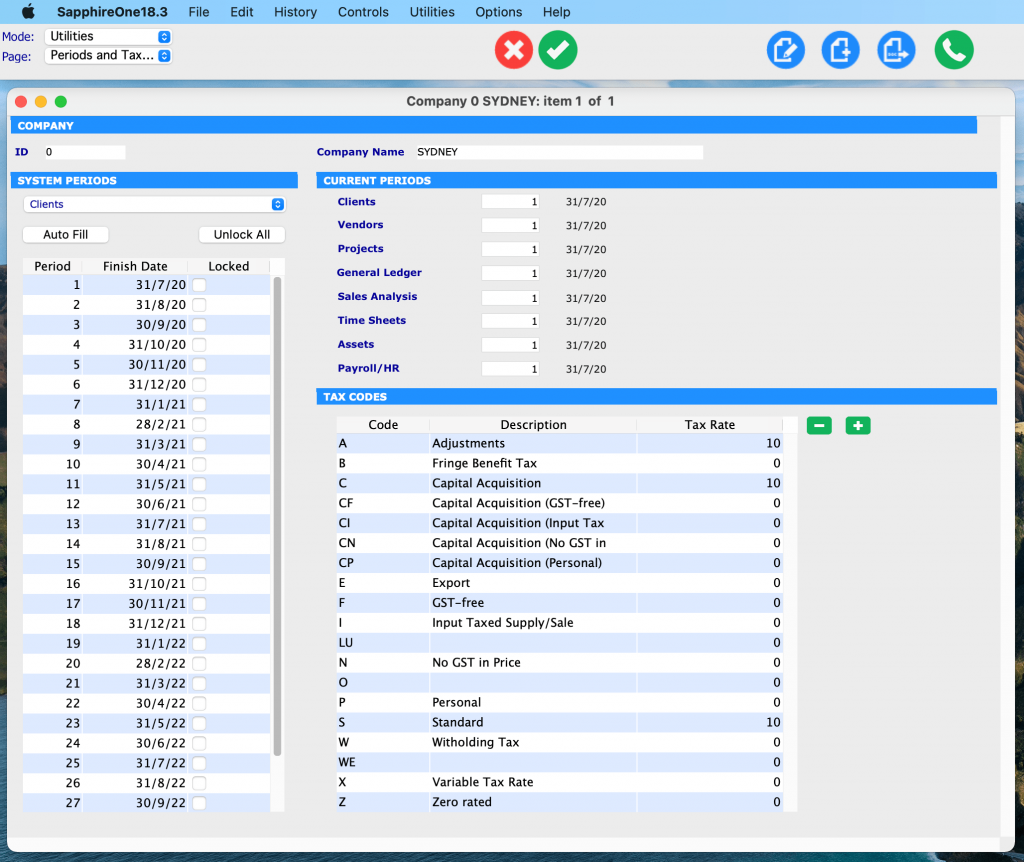
It is easy to lose oversight of all the administrative tasks that need to be performed during EOFY and it pays to be prepared.
Please make sure to follow our instructions above so that financial Year End is smooth sailing for you and your team. Our friendly support team is also available to give you a helping hand. All you need to do is book a support call with us!
You can find year-end deadlines and more information on this ATO page.
SapphireOne ERP is an effective management reporting system
August 17, 2018 5:04 pm | by John Adams

In a data-driven world, having solid and reliable data is critical to manage your business. But the real challenge lies within converting the data into actionable intelligence, to ensure it’s useful and easily understood by your employees. You need business intelligence to assess, improve performance and drive strategies to ensure your organisation has a competitive edge. With the right tools and techniques, you will stay on top of your business and ahead of the game.
SapphireOne has developed an Enterprise Resource Planning (ERP) system that’s not your average ERP system preloaded with jargon reporting tools, but a simple, logical and effective way to achieve your desired goals.
SapphireOne ERP is part of their CRM and Accounting software suit which includes modules in Accounts, Inventory, Job Projects, Assets, Payroll/HR, Management, Utilities and Workbook…. that are life changing.
Improve efficiency of resources in the delivery of organisational services with SapphireOne Management Reporting system
SapphireOne Management Reporting System (part of the ERP system) enables you to influence and play a key role in shaping your profitable business strategy. The scope of the system is extensive and designed to improve decision making, management effectiveness and efficiency of resources in the delivery of organisational services.
A key functionality of the SapphireOne ERP- Management Reporting System is automation of your traditional bookkeeping or accounting activities. This provides management with the tools to develop and formulate the right business decisions such as; identifying problems, evaluating and implementing alternate solutions and reviewing implementations.
The SapphireOne ERP- Management Reporting System will also generate effective management reports that streamline and enhance your business operations. Our system has undergone continuous development and transformation over the years making it a robust platform for reporting and management.
SapphireOne ERP, CRM and Accounting software suite is an extremely versatile product with the ability to adapt to any necessary requirements requested by the user. SapphireOne is very proud of the ongoing relationships we build with our clients; our development and support teams are on hand to assist and guide you every step of the way.
Take a look at a testimonial from Mark Fawcett, Ballarat Bolts and Fasteners. SapphireOne has provided support since the beginning, is an integral part of their business growth with systems like our SapphireOne ERP- Management Reporting System.
For a sneak peek at the full capabilities ERP, CRM, Accounting Software, Human Resources, Payroll, Assets and Document Management, check out SapphireOne and request a live demo, it is everything you’ll ever need to make your company management a success. Know more about us.
SapphireOne helps with organisation and accessibility of data
August 3, 2018 10:45 am | by John Adams

SapphireOne ERP CRM DMS accounting system is efficient in summarising, reporting and analysing your business transactions to help keep track of your expenses and income.
SapphireOne speeds up your entire accounting process through automated calculations.
SapphireOne helps you to understand your accounting system in a better way and let your accountant to assesses your organisation’s assets, liabilities, cash flow, transactions, balance sheet, cost management, reports and analysis.
Once SapphireOne is installed in your system, you can keep your business and accounts up to date easily. SapphireOne can automate tedious tasks such as filing of paperwork, with the built in Document Management System (DMS) you can attach documents of any file type directly to the transaction.
Securely convey accounting data to multiple departments across an organisation
SapphireOne is a user-friendly ERP Accounting application software that allows you to manage employees and business efficiently.
SapphireOne ERP Accounting application software gives you the advantage of viewing data in a personalised view. Using the custom inquiry screen the users have the ability to select their own criteria based on any field within the table and related tables.
SapphireOne is committed to optimising its information security performance and has achieved the ISO 27001:2013 Security Certification process by demonstrating that a comprehensive system of information security controls and management processes has been implemented.
Easily organise and access data in a central location
If you are looking to utilise a breadth of organisational functionalities for optimal management of your business’s accounting data, then SapphireOne is the answer. SapphireOne becomes the single source of truth for all your financial data including your document management system (DMS) and Contact relationship management (CRM).
The Sapphire Web Pack gives users much-needed flexibility for unlimited users to update the data file in real time from any mobile device, including iPad, iPhone or iOS and android device for anyone internet access. Data entry screens include client quotes, client orders, client invoices, vendor purchase orders, employee timesheets, employee leave requests. The users also have access to client and vendor inquiries, all the CRM capabilities such as notes on a contact, using iOS by clicking on the microphone icon to convert to text automatically.
For a sneak peek at the full capabilities ERP, CRM, Accounting Software, Human Resources, Payroll, Assets and Document Management, check out SapphireOne and request a live demo, it is everything you’ll ever need to make your company management a success. Know more about us.
Lodge your Tax Return effortlessly and spend time on your big idea
July 13, 2018 10:38 am | by John Adams

At the end of financial year whether you are in Australia, New Zealand or anywhere in the world, all companies have tax obligations. The requirement to produce your Profit & Loss and Balance Sheet at the end of the financial year is mandatory for all businesses and organisations.
A financial year (or fiscal year, or sometimes budget year) is the period used by governments and their tax agencies for accounting and budget purposes, which vary between countries. It is also used for financial reporting by business and other organizations. Laws in many tax jurisdictions/countries require company financial reports to be prepared and published on an annual basis, but generally do not require the reporting period to align with the calendar year. The End of Financial Year (EOFY) is the date that marks the end of the financial year.
The calendar year is used as the financial year by about two thirds of publicly traded companies in the United States and for a majority of large corporations in the UK and elsewhere, with notable exceptions being in Australia, New Zealand and Japan. In Australia the End of Financial year generally falls on June 30th, New Zealand ends their financial year on March 31st. Some organisations and companies follow the USA end their financial year which is often on the same day of the week each year, for example, the Friday closest to 31 December. Under such a system, some fiscal years will have 52 weeks and others 53 weeks.
Taxation laws generally require accounting records to be maintained and taxes calculated annually, which usually corresponds to the financial year used by the government. The calculation of tax on an annual basis is especially relevant for direct taxation, such as company income tax. Many annual government fees and levies—such as Council rates, licence fees, etc. are also calculated on a financial year basis, while others are charged on an anniversary basis.
Many educational institutions have a financial year which ends during the summer to align with the academic year (and, in some cases involving public universities, with the state government’s financial year), and because the university is normally less busy during the summer months. In the northern hemisphere this is July to the next June. In the southern hemisphere this is calendar year, January to December. Some media/communication-based organisations use a broadcast calendar as the basis for their fiscal year.
Whatever the size of your business and tax obligations, you must report and pay any amount due to the ATO, this includes Superannuation and GST, VAT or Sales Tax reporting. It is essential to lodge tax return accurately in order to achieve the maximum business offset and possibly even receive a tax refund.
By managing everything from Financial Reporting, Inventory Control, Assets, Job Projects, Payroll/HR to Bank Reconciliations, SapphireOne ERP CRM DMS can give you more time to do the things that matter, such as developing new strategies and thinking in your business or organisation.
SapphireOne helps you to prepare and lodge tax return
SapphireOne helps you calculate GST and seamlessly lodge your Business Activity Statement (BAS) Standard Business Reporting (SBR2), pay employees and track your PAYG and Superannuation.
SapphireOne ERP CRM DMS can generate comprehensive reports to help you prepare and lodge tax return. Effortless reporting of SapphireOne can help you to get the right data at the right time including Year to Date (YTD) financial reports, PAYG payment summaries, Profit & Loss and Balance Sheet reports.
For a sneak peek at the full capabilities ERP, CRM, Accounting Software, Human Resources, Payroll, Assets and Document Management, check out SapphireOne and request a live demo, it is everything you’ll ever need to make your company management a success. Know more about us.
Start-up business: Director must go hard or go home
March 19, 2018 10:58 am | by John Adams
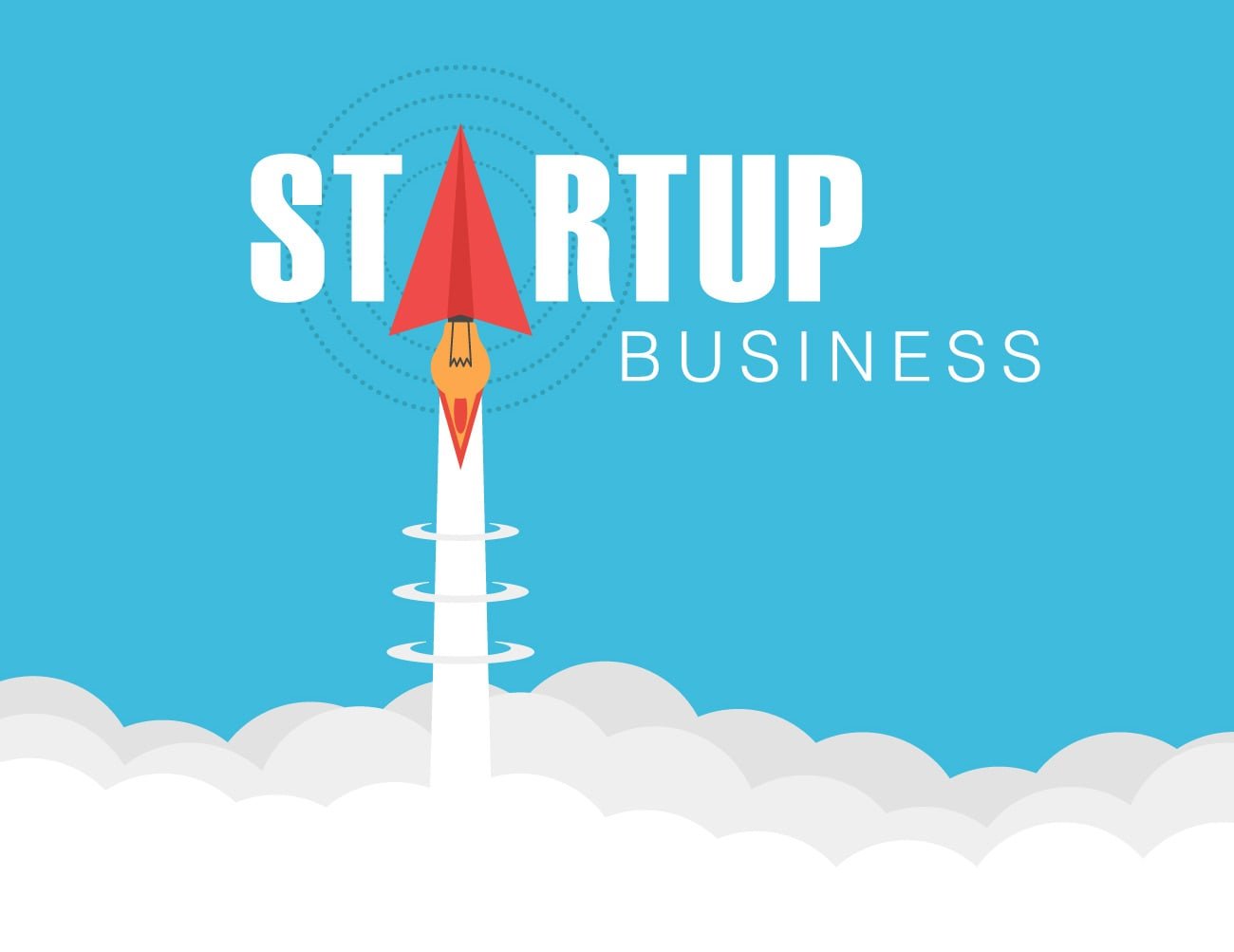
Managing a start-up business has become very difficult in the present day market conditions :
Buying a successful business is easy, buying an unsuccessful or budding business is challenging but to build a company from the scratch is one of the most difficult things. People dream about a ‘start-up’ because they have that business idea which is designed to their terms and plans.
Managing a start-up business has become very difficult in the present day market conditions because of the competition and technology advancement. The company has to take care of the revenues, expenditures, customer satisfaction as well as keep an eye on the competitors and the technology. Entrepreneurs to succeed in their start-up business should take of some important functions that will shape their business.
Corporate strategy
Do your market research and come up with new strategies everytime there is a need. Follow your competitors and their prices, research about the new products and market size for your product. Stick to the strategy and focus on acquiring new customers making sure you satisfy the existing customers.
Financial Growth
In today’s terms business growth means financial growth. So, set financial goals for your start-up business and evaluate the business regularly. Come up with new ideas on improving the financial growth and keep an account on your expenses. Manage your accounts using a software as it minimizes your costs and keeps your records upto date.
Stick to your profile
You have your basic idea about your product and how people should know your product or company, just stick to it in the beginning and develop that product. Don’t venture into unknown areas or don’t do it because your competitor is doing it. Venture into new areas only after getting success in your existing area as people will perceive a successful/failed business differently. Be specific about what you want to provide and follow the innovative ways in providing it. Look for gaps in the market and make your investment in those areas.
Business Cash flow
Tracking your sales and purchases is very important as it will decide the assets and liabilities of your company in the end. Generating revenue should be your top priority and for that you have to track every payment and you should be prepared to recover them. Keep some cash reserves as emergency to face the tough situations.
Effective management of resources and efficient handling the day-to-day business aspects inspires the success of your start-up business and for that you have to employ management systems like ERP and CRM.
For a sneak peek at the full capabilities ERP, CRM, Accounting Software, Human Resources, Payroll, Assets and Document Management, check out SapphireOne and request a live demo, it is everything you’ll ever need to make your company management a success.
Maintain the records stored in the database via SapphireOne’s Asset Inquiry
March 2, 2017 3:21 pm | by John Adams
Assets is the resources of the business. It is the material one has, to make a difference. A nice term for it is something that has probable future economic benefit, or which has a future and is potentially valuable. For example, food in the refrigerator is an asset because it has a value and we can eat it. Asset Inquiry and management refers to the management of your company’s assets. The term also applies to dealing with other organisations’ or companies’ investments. Assets can be tangible, are things we can touch and include buildings, land, computers, or office equipment. Intangible assets are things we cannot touch such as intellectual property, goodwill, financial assets, or human capital.
Asset Inquiry in a Business
In business, assets usually classed in the following way–
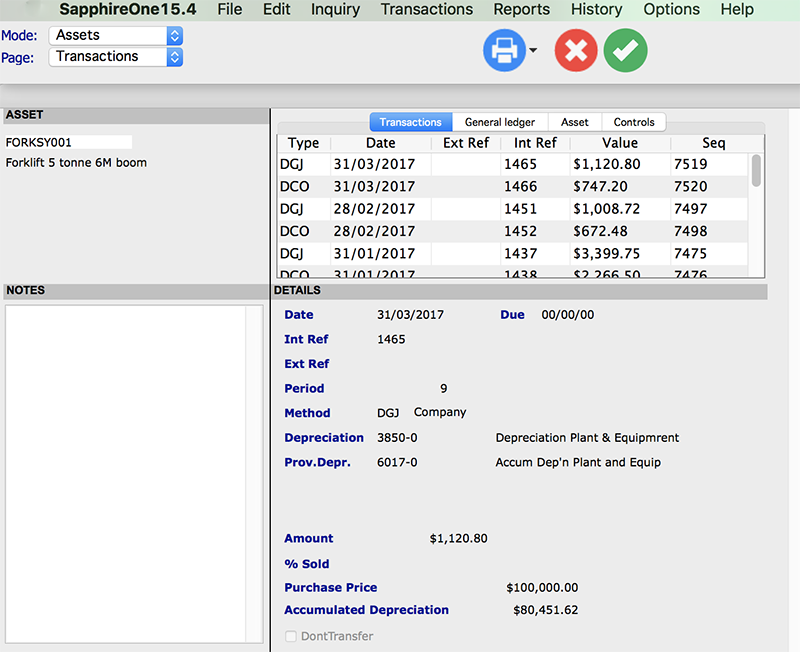
Sapphire single user and SapphireOne client server asset inquiry and management functionality makes managing assets a breeze. In SapphireOne it is easy to manage assets owned by a company or by an individual. SapphireOne ensures you to keep track of the depreciation that occurs on those assets . To know more , Check SapphireOne’s Asset inquiry module.
